Setting Up a Live Virtual Classroom During Coronavirus Lockdown
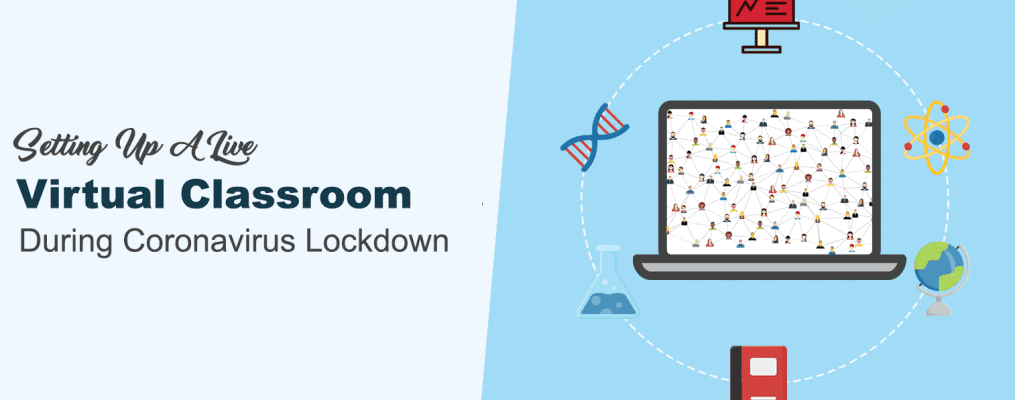
Technology
The Novel Coronavirus (COVID-19) has taken the entire world by storm through the exponentially growing number of cases daily. Helplessly amid the lockdown over the full-blown global pandemic, many schools, coaching institutes, and universities worldwide have had to shut their facilities for over the next few weeks. According to UNESCO, nearly 80% of the world’s student population has been affected by the closure of educational institutions, as over 138 countries have implemented nationwide closures to prevent the spread of COVID-19.
Since there’s no timetable for when they might reopen, educational institutions are now offering study-from-home options to their students, as an alternative to classroom training. These options include:
- Online Courses: Involves the viewing of pre-recorded, asynchronous educational multimedia material by students.
- Virtual Classrooms: Involves live, one-to-one interaction between teachers and students.
As virtual classrooms are equipped with multiple communication and file-sharing tools that allow both instructors and participants to interact, engage, and exchange ideas in real-time, they prove to be a far better mode of online teaching than Online Courses. So, if you are also planning to set up a live virtual classroom during the Coronavirus outbreak, here is everything you need to know.
In this article:
- What is a Virtual Classroom?
- What Are the Advantages of Virtual Classroom?
- What Are the Different Types of Virtual Classrooms?
- What Are the Must-Have Features of a Virtual Classroom?
- The Top 10 Virtual Classroom Software?
- WordPress Plugins to Set Up a Virtual Classroom
- Tips for Virtual Classroom Success
What is a Virtual Classroom?
A virtual classroom is a digitized, online replica of a traditional physical classroom. It serves as an online teaching and learning environment where participants (instructors and learners) can communicate, interact, collaborate, and engage in teaching and learning activities. With a virtual classroom, you can do just about anything you do in a real-world face-to-face classroom.
Also known as a Virtual Learning Environment (VLE) or Online Classroom, a Virtual Classroom can be used for both synchronous and asynchronous learning. While it employs multiple synchronous technologies, such as live streaming, web conferencing, and web-based VoIP, it also relies on a variety of asynchronous communication tools, such as live chat and message boards, to make the learning experience similar to a real-world classroom.
What Are the Advantages of Virtual Classroom?
Although an Online Classroom is fundamentally quite similar to the traditional campus-based classroom, learning through a virtual classroom offers several unique benefits that a conventional physical classroom could never provide:
#No Geographical Barriers
Eliminating the constraints of time and location, a virtual classroom provides learners the freedom to join a class from anytime, anywhere in the world. All you need to have an Internet connection, a computer, and a headset equipped with a microphone.
#Cross-device Compatibility
An online classroom is usually compatible with a range of devices used by people these days. Not only on desktop computers or laptops, but you can also join an online classroom even on your tablet or smartphone. You can join a class on your laptop and continue it on your mobile phone on the go.
#Multimedia Content
Besides live online sessions, virtual classroom software also allows instructors to create, upload, and share various types of multimedia content such as images, audios, videos, presentations, and more. This makes the learning process more enriching and comprehensive for participants. On the contrary, a physical classroom offers no such facilities.
#Automatic Grading
With virtual classroom software, you can evaluate the performance of your students in the blink of an eye. Not only can you put grading on autopilot, but also you can automate many processes such as attendance. Where teachers can appraise tests automatically; on the other hand, students get to know their scores instantly.
#Post Class Reinforcement
If a student misses a traditional classroom-based session, he has very little opportunity to experience the same thing again. Since most online classroom sessions can be recorded, participants can replay the entire session or its specific part afterward to reinforce classroom learnings. Teachers can also review and improve their performance through recorded sessions.
#Interaction and Retention
During the live online class, you can drive real-time interactions with your students by engaging them through polling questions, quizzes, games, and surveys that encourage discussions and drills-in key learning.
#Scalable
Virtual classrooms are highly scalable. Means, you have the freedom to scale offerings up or down when required. Unlike traditional classrooms, which have limited infrastructure and resources, online classrooms are not a constraint to anything.
#Save Cost and Time
According to a report, a virtual classroom typically requires 40 to 60% less time learning the same material in a traditional physical classroom. Additionally, bringing learners from different locations together, an online classroom cuts the cost of travel, infrastructure, and learning materials.
What Are the Different Types of Virtual Classrooms?
Virtual classrooms can be divided into five main categories:
#Enriched Virtual Classroom
A combination of some face-to-face and mostly online learning, an enriched classroom model allows every student to carry out most of their projects at home. The best thing about this model is that you don’t have to attend the class on a daily basis. You can attend the class, depending on your schedule. This model is often based on a single course or series of courses.
#Rotation Model
This model is generally based on a single subject that all students can be a part of, and it falls under blended learning. The students stick or rotate to a single schedule between the classroom and at-home learning.
#Fully Virtual Classroom
This technical model aims at researching, conceptualizing, and designing. It emphasizes on doing all the coursework online. There are no interactive sessions; however, students can communicate via a synchronized collaborative platform.
#Flex Virtual Classroom
This model focuses on offering a flexible learning environment for non-traditional learners. In this model, learning materials, along with instructions, are provided. Tutors are always available, and students are allowed to leave or attend the class as per their convenience.
#A La Carte Model
In this model, students can take one or more courses entirely online while continuing to take their curriculum at a traditional school or learning center. The instructor of record for the a la carte course is the virtual instructor.
What Are the Must-Have Features of a Virtual Classroom?
Some of the features you should look for while choosing the best virtual classroom software are:
- High-definition Video Conferencing
- Advanced Interactive Digital Whiteboard
- Option to Schedule and Launch Live Classes
- Archived Lessons and Resources
- Mobile/Tablet Optimized
- Interactive Features such as Polling, Quizzes, Polls, and Surveys
- Instant Communication Tools, including Group Chats
- Live Screen & Content Sharing Capabilities
- Ability to Upload Pre-recorded Content
- Real-time Insights and Analytics
- Ability to Record and Replay Live Sessions
- Timed Testing and Assessment Options
- Progress Metrics
- Attendance Report
- Countdown Timer
- Reference Modules
- Cloud Storage & Backup
- Learner Engagement Tracking
- Advanced Collaboration and Moderation Tools
- Integrated Content Library
- Classroom Management Functionality
- Availability in Multiple Languages
- LMS (Learning Management System) Integrations
The Top 10 Virtual Classroom Software?
To help you on your journey of virtual teaching, here a list of the best and most popular virtual classroom tools and software available in the market today:
1: Google Classroom
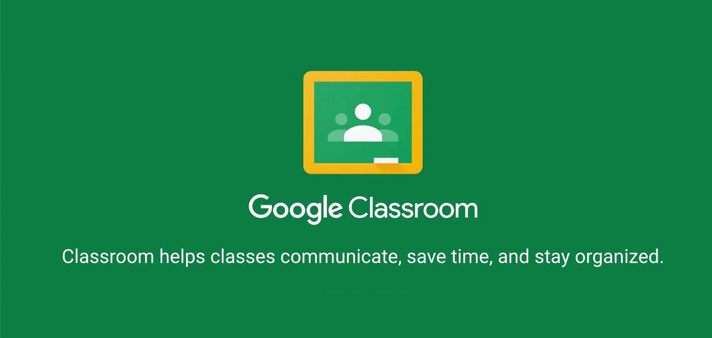
If you’re looking for a free, easy-to-use virtual classroom solution, then Google Classroom can be a perfect choice for you. In fact, Google Classroom is the most popular education app on both Android and iOS amid Coronavirus breakdown.
Key Features Include:
- Designed for a more productive, collaborative, and meaningful teaching
- Assign, reuse, collaborate and, and grade coursework securely
- Post, comment and facilitate classroom discussions
- Integration with thousands of educator-approved apps</.li>
- Work anywhere, anytime, and on any device
2: LearnCube Virtual Classroom
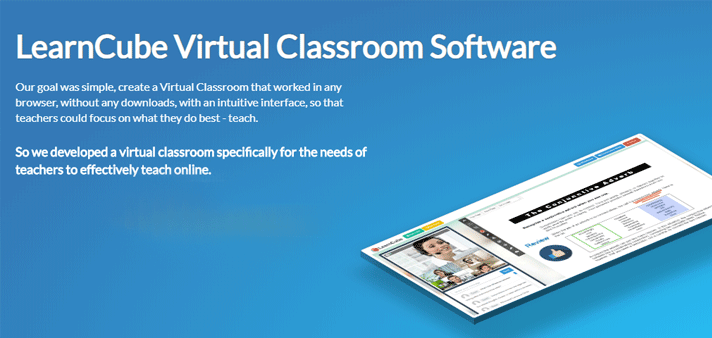
LearnCube offers a browser-based virtual classroom that features an intuitive interface and requires no downloads. Designed specifically with the needs of teachers in mind, this handy software helps teachers focus on how to teach more effectively and professionally online. LearnCube even is offering a free plan for those impacted by the Coronavirus.
Key Features Include:
- Online Whiteboard
- Private and Group Classes
- File & Media Sharing
- Class Review & Recordings
- Schedule Upcoming Classes
- Real-time Chat & Conversation Mode
- LMS Integration
3: Electa Live
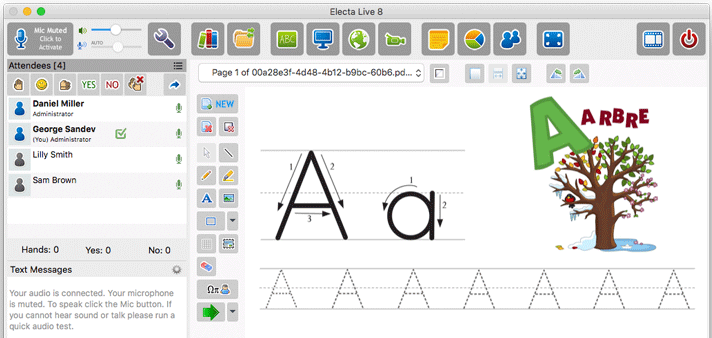
Electa Live is one of the most popular virtual classroom software out there. Backed by a robust learning management system, this cross-platform tool lets you easily create online courses and tutorials, organize live online group classes, lectures, meetings, and individual one–on–one tutoring sessions.
Key Features Include:
- Live Video Conferencing
- Shared Interactive Whiteboards
- Rich Markup & Annotation Tools
- Screen Sharing & Remote Control
- Session Recording and Playback
- Breakout Rooms for Individual Collaboration
4: WizIQ
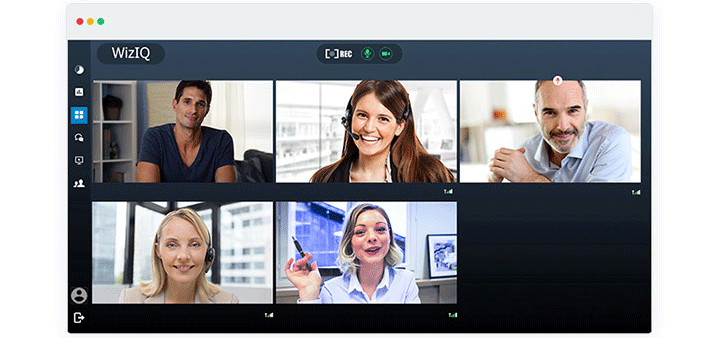
WizIQ offers a browser-based HTML5 virtual classroom with both WebRTC and Flash options. It doesn’t require you to download any bulky software or plugins to join a session. You can even integrate online classroom functionality with your existing LMS, CMS, or website by using API or plugins.
Key Features Include:
- High-definition Video Conferencing
- Advanced Interactive Whiteboard
- Insights and Analytics
- Collaborative Code Editor
- Real-time Online Collaboration
- Live Screen Sharing
5: Virtual Classroom by ProProfs
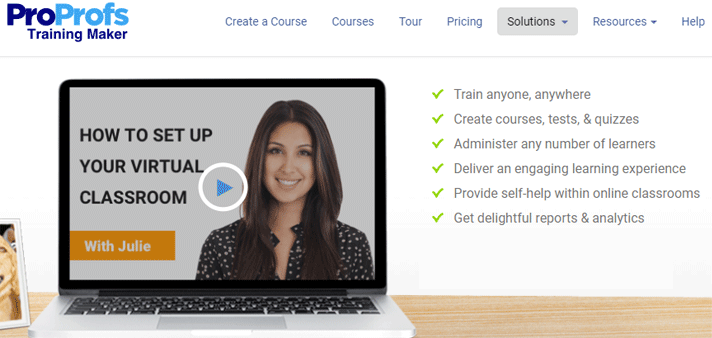
ProProfs virtual classroom software facilitates you to easily create an online classroom as well as build online courses. Supporting more than 70+ languages, it works seamlessly on all mobile, tablet, and desktop devices as in-house or remote software. You can teach anyone anywhere across the globe with this exceptionally-powerful tool.
Key Features Include:
- Create Courses, Tests, Quizzes, and Surveys
- Public or Private Courses
- Administer Any Number of Learners
- Advanced Reports and Analytics
- Send Reminders, Announcements, and Handouts
- Choose from 100+ Customizable Courses
6: Unicko
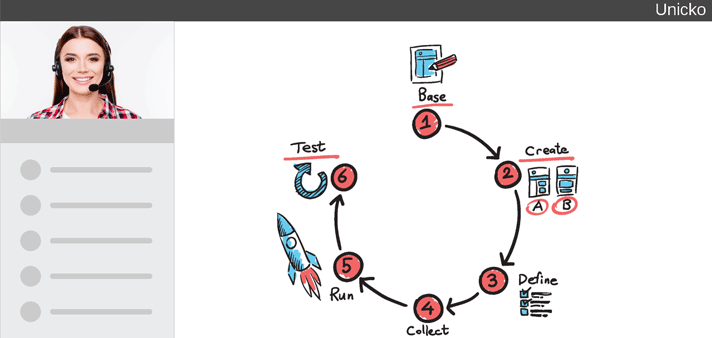
A perfect combination of interactivity and collaboration, Unicko has all the essential tools you need to create a highly interactive live classroom. With an easy-to-use, intuitive user interface, Unicko requires no installation and offers a single persistent online teaching experience for all use cases.
Key Features Include:
- Audio and Video Conferencing
- Whiteboard & Markup Tools
- Live Chat & Polls
- Session Recording
- Screen Sharing
- Games, Quizzes, and Presentations
- LMS Integration
7: BrainCert Virtual Classroom
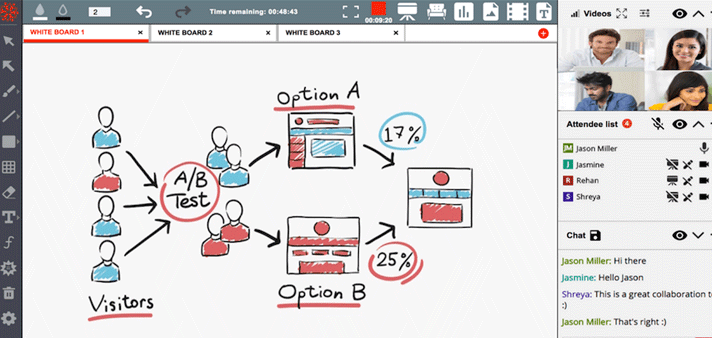
BrainCert claims to offer the world’s first WebRTC powered HTML5 virtual classroom. Available in over 50+ languages, this next-generation online classroom functions in nearly the same way as a real-world classroom and leverages the power of cloud computing to facilitate both synchronous and asynchronous learning.
Key Features Include:
- Ultra HD Audio and Video Conferencing
- High-quality Voice Over IP (VoIP)
- Interactive Whiteboards
- Group Text Chat
- Highly Intuitive HTML5-based Group Screen Sharing
- Server-side HTML5-based Session Recording
8: Samba Live

Sabma Live is another 100% HTML5 and WebRTC based virtual classroom software that runs in your web browser without additional downloads. With this handy tool, you can set up beautiful, adaptable, and collaborative online classrooms in minutes.
Key Features Include:
- HD Video Conferencing
- Full HD MP4 Cloud-based Recording
- API and LTI/LMS integration
- Screen Sharing
- Advanced Scheduling
- Multi-user Whiteboard
- Questions, Answers, and Polling
9: Kaltura Virtual Classroom
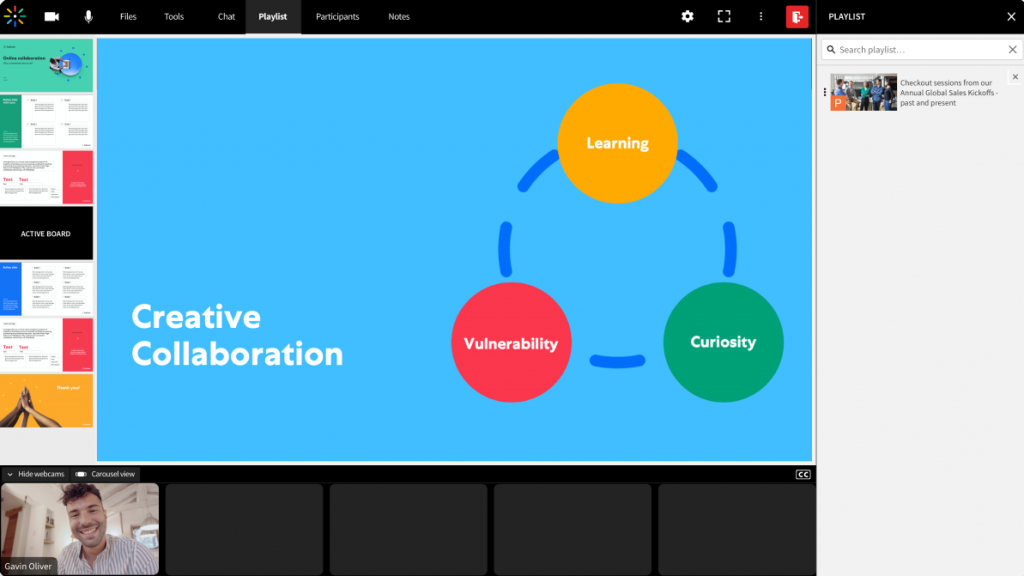
Kaltura’s smart online classrooms are purposely built for online instruction. With a click of the mouse, remote instructors, facilitators, and teachers can engage their audience effectively online as if being in the same room. As classrooms are 100% browser-based, nobody needs to download anything to participate.
Key Features Include:
- An Easy-to-use Interface
- Real-time Audio and Video
- Digital Whiteboard
- Record and Archive Your Classes
- HD Screen Sharing
- Real-time Notes
- Live Quizzes
- LTI/LMS integration
10: VEDAMO Virtual Classroom
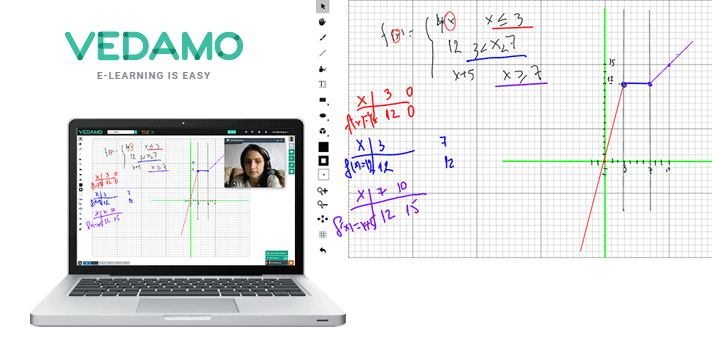
VEDAMO offers a potent collaborative web conferencing tool using which teachers and tutors can conduct highly interactive live online sessions. Designed to be used by both kids and non-tech savvy users, this web-based classroom software offers a rich set of tools to make online teaching a fun, engaging experience for everyone.
Key Features Include:
- Online Whiteboard
- Video-conference
- Screen-sharing
- Breakout Rooms
- Mobile Device Ready
- File Sharing
- Recording
- LTI Integrations
In addition to the above-mentioned online classroom tools and software, you can also try Blackboard Collaborate and Adobe Connect Virtual Classrooms.
WordPress Plugins to Set Up a Virtual Classroom
If you already have a WordPress site, you can use these plugins to create a virtual classroom:
1:WizIQ
This plugin brings the power of the WizIQ virtual classroom to your WordPress site. Once installed and activated, the plugin turns your ordinary website into a highly interactive online classroom, allowing you to perform all classroom functions from your WordPress site.
2:BrainCert
Likewise, BrainCert also offers a plugin to use their virtual classroom functionality within your WordPress website. To use the plugin, all you need to generate an API key from their website and enter it in plugin settings.
Since there are not many plugins in WordPress to create a live virtual classroom, you may hire expert WordPress developers from a reliable WordPress development company to create a custom virtual classroom plugin for you.
Tips for Virtual Classroom Success
Lastly, to make your virtual classroom a success, here are a few practical tips that you can follow:
- Plan your session
- Establish ground rules
- Design materials to engage
- Interact with your audience as much as possible
- Add captions to your live classes
- Ask as many questions as possible
- Set polls, surveys, and quizzes
- Form Groups and use virtual break-out rooms
- If possible, offer an online library of learning material


